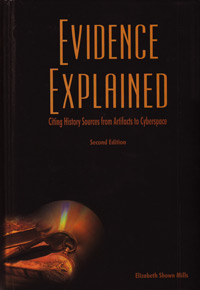 When I first picked up Evidence Explained, Citing History Sources from Artifacts to Cyberspace, I read the Foreword and Acknowledgemen,t then skimmed a few pages. I immediately shut the book and said something to the effect of, “this is too academic.” Then I thought about it. My friend and the author, Elizabeth Shown Mills, is an academic. Now, before you get excited, let me explain.
When I first picked up Evidence Explained, Citing History Sources from Artifacts to Cyberspace, I read the Foreword and Acknowledgemen,t then skimmed a few pages. I immediately shut the book and said something to the effect of, “this is too academic.” Then I thought about it. My friend and the author, Elizabeth Shown Mills, is an academic. Now, before you get excited, let me explain.
I find practiced scholars and academics have a particular way of writing. I would not wish to read a novel written in such a style or tone. However, a thoroughly vetted and practical guide such as Evidence Explained merits the tone of academia and is well served, in this case, by the author’s expertise and serious approach to the subject of citation. I cannot imagine a more thorough rendering of citation for all types of sources. Mills has gone far beyond the basics of citing books, newspapers, and other common sources. She has taken on all types of records from archives and artifacts to church records to just about any resource a genealogist might come across.
The book also goes into the often confusing area of citing digital sources. Websites, audio files, podcasts, microfilm, reprints, and revisions all receive significant coverage. Chapter by chapter, each reference category is covered in two parts. First, a list of citation models, including first reference and additional referencing options, shows how to create the various citations. Each is listed by media or source type. For example, under the chapter for Censuses, models include: original manuscripts, digital images online commercial site, digital images online archives (France), microfilm Native-American Tribal Census, and many more.
Following the list of models in each chapter, an additional list of guidelines and examples are given. These guidelines examine issues and usage elements the researcher may need to consider when citing sources. For example, again under the Census chapter, items include: ‘Ancient’ vs. ‘Modern’ Censuses, arrangement of elements in reference notes, citing dates of enumeration, citing roll numbers, etc.
Evidence Explained is used by many in the genealogy world. Some consider it the premier source on citation. Other historians even teach citation to fellow researchers strictly using this book as a guide. The table of contents seems too short for the depth of knowledge found in all 885 pages.
Table of Contents
Foreward
1 Fundamentals of Evidence Analysis
2 Fundamentals of Citation
3 Archives & Artifacts
4 Business & Institutional Records
5 Cemetery Records
6 Census Records
7 Church Records
8 Local & State Records: Courts & Governance
9 Local & State Records: Licenses, Registrations, Rolls & Vital Records
10 Local & State Records: Property & Probates
11 National Government Records
12 Publications: Books, CDs, Maps, Leaflets & Videos
13 Publications: Legal Works & Government Documents
14 Publications: Periodicals, Broadcasts & Web Miscellanea
Appendixes
A Glossary
B Bibliography
Index
Index: QuickCheck Models
Tab This Book!
Another professional genealogist friend, Patricia Walls Stamm, CG, CGL, pointed out to me just last week that she has tabbed her Evidence Explained volume, making it much quicker to use. That make sense, as this is a volume that serious genealogists find themselves turning to constantly. It’s another of those few genealogical “on the corner of the desk” books.
To order your copy of Evidence Explained, Citing History Sources from Artifacts to Cyberspace; please visit Family Roots Publishing; Item #: GPC3843
Psst… the electronic version of Evidence Explained is on Elizabeth’s EE website bookstore at https://www.evidenceexplained.com/magento/ for only $29.99 — that’s half the price of the hard copy! And it’s much easier to search for that elusive citation in the electronic version! I have both, but use the electronic version (PDF, in my case) much more often, as I always have it with me on my iPad.